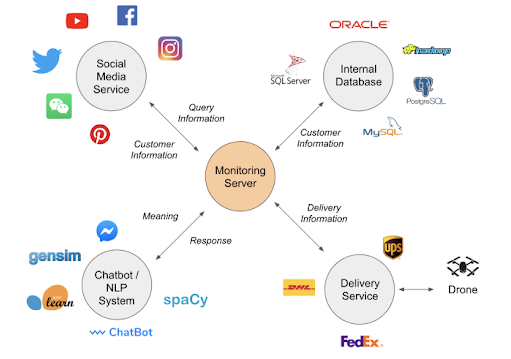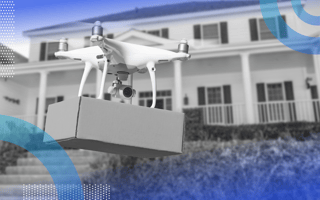We all know data is the future. Data can drive growth, lead us to better decision making and provide added value — but just how does this all work? For the uninitiated, let’s discuss a hypothetical example of how you can put data and data processes to work to improve your operations. We won’t dive too deep into the technologies, so no matter your skill level — read on!
The Case
Suppose you’ve ordered something from your favorite e-commerce company, Amazon. But, since you’re a true millennial, you’re impatient. You want the new sneakers you ordered yesterday to arrive right now, so you post on your favorite social media platform, Twitter:
hey @amazon, I ordered my sneaks. When are they coming? today?
And let’s imagine that Amazon has its act together so you instantly receive a reply that your new Yeezy Boost 350s will be with you soon. They’re on their way and the drone that’s delivering them is going to land in your house in 30 minutes. Pretty neat stuff. You’re happy to know this so you watch one more episode of The Great British Bakeoff on Netflix and prepare for your impulse purchase to arrive.
But how? Let’s dive into the work that happens in the background to make all this possible.
What Data Systems Deliver My Amazon Package?
- social networking services for query/question information
- chatbot/NLP system for understanding natural language
- internal databases for getting all the required customer information
- delivery service for understanding how the deliveries progress
The Hidden Magic
There are many moving parts that must work together to make these seemingly simple steps a reality. The diagram below details the flow between five individual systems for a general case.

Let’s follow the data as it moves through this system.
Monitoring
Much the same way any big company would have a receptionist monitoring walk-ins, in the digital age, we’re required to have internet receptionists monitoring our digital storefronts around the clock. Many big companies are already doing this; in fact, investors are even using tweets as a way to understand a company’s overall performance.
Amazon needs to connect to the social media platform on which you made the comment and realize this comment was directed at the company. To do this, they need to monitor their social media in real time. For big social media platforms, an API monitors their account for any posts or mentions.
Understanding
Once the API notices the message, it must decipher it. “hey @amazon, I ordered my sneaks. When are they coming? today?” needs a different response than “hey @amazon, your service sucks.”
We can do this by simply matching keywords in the text, or as is more common today, using natural language processing (NLP) techniques, which fall under the umbrella of AI. Regardless of the chosen path, the message would (hopefully) be correctly classified as ORDER_QUESTION.
Next, the system needs to figure out who the person is through the social media company. To do this, the system needs to exchange data with the social media company on your profile. Thankfully, there are many options. The social media platform can share the email or a name of the user, or if the user initially signed up with their social media account on Amazon through single sign-on (SSO) then the system can find your associated account very quickly. If the system can’t find any of this information, it can instead follow up immediately by asking for an order ID through a chatbot. At this point, the system is looking for the customer’s fingerprints.
Processing
Once the system identifies the customer, the data needs to be connected to an internal database. The internal database will have a record of all the transactions made by that user and, in particular, any orders due for delivery. Typically the system will access the database with some type of querying language such as SQL.
This will tell us what the order is, but where is it? To find this out, the system has to connect with the order tracking system. In many cases this would be some third-party, like Lalamove, who manage delivery. This step requires another API connection.
They know the sneakers left the warehouse one hour ago, but how long until they’re delivered? To find this out they connect directly to the drone your package is in and, using its GPS, works out the location. Now, because we want to be really accurate, the data that’s collected so far is run through a machine learning model to get the estimated time left for the goods to be delivered.
Responding
With this, the system identifies a final delivery time, and — using the chatbot — responds to the customer on Twitter, telling them the sneakers will arrive in 30 minutes. As a user, you’ll never see what’s going on here, and you might be waiting less than one minute for all this to happen.
A Long Journey
We’ve seen that what may appear to be a simple task for a consumer has a lot going on in the background. We have API calls to social media platforms, SQL calls to a database, a bit of internet of things as we connected to a drone, as well as machine learning models at work.
But what’s the point of all this? Well, this sort of customer service enables companies to build a reputation which can eventually transform into a leading position in the market. This complex process adds value in a far more nuanced way than just slashing the price of products. These sort of data-driven approaches are very hot and there are a lot of companies fighting to come out on top in this space.
Hopefully this has been a good example of the operations you can employ by collecting and combining all sorts of data. Just remember, it doesn’t have to be this complicated; many organizations use data in simpler ways to optimize their operations and drive growth. Don’t forget to consider what’s best for your company and how you can add value to your customers.





